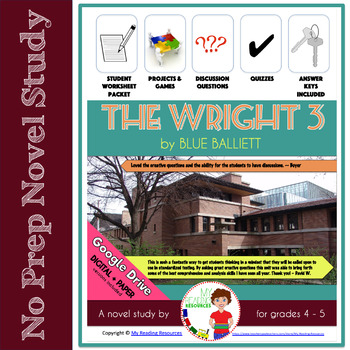The Wright 3 by Blue Balliett Novel Study
- PDF
- Google Apps™
- Easel Activity

Description
Comments from buyers:
- “Loved the creative questions and the ability for the students to have discussions.”
- “This is such a fantastic way to get students thinking in a mindset that they will be called upon to use in standardized testing. By asking great creative questions this unit was able to bring forth some of the best comprehension and analysis skills I have seen all year. Thank you!”
This is a 90+ page Common Core aligned no prep novel study for The Wright 3, by Blue Balliett. This novel study teaching unit has everything that you will need to teach and assess the novel. The table of contents makes finding information quick and easy. The 28-page student packet is perfect for literature circles or independent work. ALL ANSWER KEYS ARE INCLUDED.
GO DIGITAL! Choose printed or paperless resources! The student packet, final quiz, supplemental worksheets, and Dive Into the Book review game are available as Google Drive files. A vocabulary and definitions list is also included to allow you to easily import into Flippity, Kahoot, Quizlet, etc. to create digital flashcards or word games.
••••••••••••••••••••••••••••••••••••••••••••••••••••••••••••••••••••••••••••••••••••••••••••••••••••••••••
⮕⮕⮕Planning on purchasing multiple copies or additional resources?
⚡⚡⚡Save money with a Custom Bundle!
⮕⮕⮕Looking for a different title or a lesson targeted to a specific standard?
⚡⚡⚡Request a Product! We'll create a product specifically for you. There's no commitment to buy, but if you purchase within the first 24 hours, you'll receive the product at 50% off!
••••••••••••••••••••••••••••••••••••••••••••••••••••••••••••••••••••••••••••••••••••••••••••••••••••••••••
Included in this Novel Study Guide:
Introductory and Informational Materials:
▸CCSS Checklists for grades 4 – 5
▸Teacher’s notes with Internet resources and suggestion for vocabulary practice
Vocabulary Building Materials:
▸Student Glossary (digital option)
▸Word Wall Cards
▸Vocabulary and Definition Cards
▸Vocabulary Quiz (answer key included)
Student Packet (divided into 4 sections) (digital option) featuring:
▸Vocabulary
▸Chapter Questions
▸Focused Questions on Figurative Language and Synonyms/Antonyms
▸Discussion Questions
▸Writing Prompts
▸Student Projects
Skill Building Activities and Worksheets:
▸Character Compare and Contrast Graphic Organizer (digital option)
▸Theme Graphic Organizer (digital option)
▸Latin Prefixes Supplemental Worksheet (digital option)
Activities Included in this Book Study:
▸Calder’s Codes Decoding Worksheet (supplemental) (digital option)
▸The Wright 3 Question and Answer Dice Game
▸Dive Into the Book Review Game (race) (digital option)
Easy to Grade Assessments:
▸Vocabulary Review Quiz (matching)
▸Review Quiz (M/C plus short writing prompt) (digital option)
Common Core Standards utilized with this unit:
RL 4.1, 4.2, 4.3, 4.4, 4.6, 4.10
RL 5.1, 5.2, 5.3, 5.4, 5.6
L 4.4.a,b,c
L 4.5.a,b,c
L 5.4.a,b,c
L 5.5.a,c
W 4.1, W4.9a
W 5.1, 5.9a
Skills addressed in this book study guide include:
▸define words using a dictionary or glossary
▸identifying figurative language (hyperbole, idiom, metaphor, simile, personification)
▸literal versus nonliteral meanings
▸point of view
▸making inferences
▸describe the traits of main characters
▸providing textual support for opinions
▸compare and contrast
▸theme
▸analyzing the impact of illustrations on the reader’s experience of reading the text
▸summarizing
▸Latin prefixes
▸compare and contrast two books by the same author (student project)
Curriculum tie-ins or occasions:
▸architecture
▸Frank Lloyd Wright
▸Chicago
▸mystery
Just looking for assessments?
Purchase the comprehensive quiz as a stand-alone product here.
★ ★ ★ ★ ★ ★ ★ ★ ★ ★ ★ ★ ★ ★ ★ ★ ★ ★ ★ ★ ★ ★ ★ ★ ★ ★ ★ ★ ★ ★ ★ ★ ★ ★ ★ ★ ★
Questions or comments? Contact My Reading Resources directly at: myreadingresources@yahoo.com.
★ ★ ★ ★ ★ ★ ★ ★ ★ ★ ★ ★ ★ ★ ★ ★ ★ ★ ★ ★ ★ ★ ★ ★ ★ ★ ★ ★ ★ ★ ★ ★ ★ ★ ★ ★ ★
©My Reading Resources. All rights reserved. Purchase of this unit entitles the purchaser the right to reproduce the pages in limited quantities for classroom use only. Duplication for an entire school, an entire school system, Outschool, or commercial purposes is strictly forbidden without written permission from the publisher.
Copying any part of this product and placing it on the Internet in any publicly accessible (not password protected) form (even a personal/classroom website) is strictly forbidden and is a violation of the Digital Millennium Copyright Act (DMCA). These items can be picked up in a Google search and then shared worldwide.






